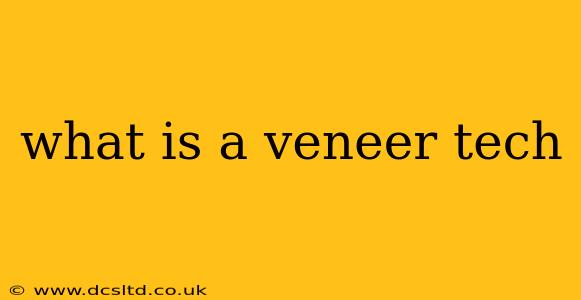Veneer tech, while not a formally recognized term in the tech industry, broadly refers to technologies that utilize thin layers of materials—often just micrometers or nanometers thick—to achieve specific functionalities. These "veneers" are applied to a base substrate, adding a new layer of capabilities without significantly altering the underlying structure. Think of it like applying a sophisticated sticker with unique properties to a surface. This concept touches several areas, and understanding its various applications requires exploring different contexts.
What are the different types of veneer tech?
The term encompasses a wide range of technologies, making a precise definition challenging. However, we can categorize them based on their application and material:
1. Material Science & Engineering: Here, veneer tech involves depositing thin films of materials like metals, polymers, ceramics, or semiconductors onto substrates. This is crucial in fields like:
- Microelectronics: Creating transistors, integrated circuits, and other components relies heavily on depositing thin layers of conductive and semiconductive materials.
- Coatings: Applying protective or functional coatings to surfaces—think scratch-resistant glass on smartphones or non-stick coatings on cookware—is another prime example.
- Optoelectronics: Creating displays, solar cells, and other light-manipulating devices requires precisely controlled thin-film deposition of materials.
2. Biomedical Applications: In medicine, veneer tech plays a role in:
- Drug delivery: Thin films can be engineered to release medication at controlled rates.
- Biosensors: Thin film sensors can detect biological molecules and provide real-time data.
- Tissue engineering: Thin films can serve as scaffolds for tissue regeneration.
3. Advanced Manufacturing: This area is witnessing increasing innovation:
- 3D printing: Adding thin layers of material incrementally is the very essence of additive manufacturing.
- Flexible electronics: Creating flexible displays and circuits requires thin, flexible substrates and thin-film components.
What are the benefits of veneer technology?
The advantages of veneer technologies are numerous:
- Enhanced Functionality: Adds desired properties (conductivity, strength, optical effects) without changing the bulk properties of the base material.
- Miniaturization: Enables the creation of incredibly small and compact devices.
- Cost-Effectiveness: In some cases, using thin films can be more economical than using thicker layers of the same material.
- Lightweight: Reduces weight, important in applications like aerospace and portable electronics.
- Improved Performance: Tailoring the thin-film properties can optimize device performance.
How does veneer tech differ from other technologies?
Veneer tech contrasts with other technologies in its focus on thin layers. Instead of fundamentally altering the bulk material, it enhances existing materials with added functionalities through precision deposition. This contrasts with bulk material processing, where the entire material undergoes change.
What are some examples of veneer tech in everyday life?
Many everyday products leverage veneer tech:
- Smartphone screens: The protective glass is often coated with thin films for scratch resistance.
- Solar panels: The photovoltaic cells utilize thin films of semiconductor materials.
- LED lights: Thin films are crucial for creating efficient LED lighting.
What is the future of veneer tech?
The future of veneer tech looks incredibly promising. As materials science and nanotechnology advance, we can expect even thinner and more sophisticated films with tailored properties. This will lead to innovations in various fields, including more powerful and energy-efficient electronics, advanced medical devices, and sustainable manufacturing processes. The development of new deposition techniques and novel materials will continue to drive this progress.
